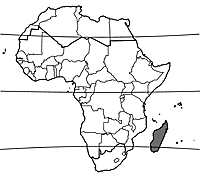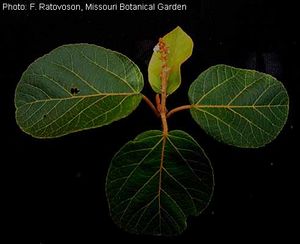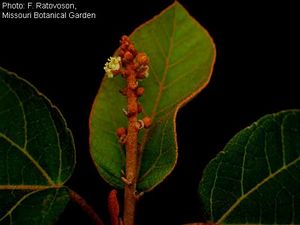Croton mongue (PROTA)
Introduction |
Croton mongue Baill.
- Protologue: Adansonia 1: 158 (1861).
- Family: Euphorbiaceae
Origin and geographic distribution
Croton mongue is endemic to northern and eastern Madagascar.
Uses
The wood, locally known as ‘molanga’, is occasionally used, mainly for laths of tiled roofs, support poles for crops, fence posts, boxes and matches, and as firewood. It is suitable for joinery, moulding, plywood and particle board. An infusion of the bark is administered as a tonic in cases of anorexia, fatigue and depression. Bark and leaf decoctions are applied in bathes and lotions to treat blennorrhoea.
Properties
The heartwood is whitish and not distinctly demarcated from the sapwood. The grain is straight, texture medium. Wood surfaces are slightly lustrous. The wood is lightweight, with a density of 400–560 kg/m³ at 12% moisture content. It air dries rapidly, with moderate risks of distortion, checking and collapse. Boards of 4 cm thick take 5–6 months to air dry. Once dry, the wood is only moderately stable in service. The rates of shrinkage during drying are low.
At 12% moisture content, the modulus of rupture is 98–139 N/mm², modulus of elasticity 9000–11,000 N/mm², compression parallel to grain 38–48 N/mm² and Chalais-Meudon side hardness 1.5–2.8.
The wood is easy to saw and work with hand and machine tools. It usually planes and sands to a smooth and lustrous surface. The screwing, gluing, varnishing, painting and jointing properties are all satisfactory. However, the nail-holding capacity is only moderate. The wood is suitable for rotary-cut veneer. It is not durable, being liable to attacks by fungi and insects. It is easy to impregnate with preservatives.
A toxic protein, monguine, was extracted from the seeds; it inhibits protein synthesis.
Description
- Evergreen shrub to small or medium-sized tree up to 20(–30) m tall; bole up to 50(–60) cm in diameter; bark surface smooth to slightly rough, whitish, with lenticels, inner bark brown to greenish brown; crown rounded; twigs densely short-hairy.
- Leaves alternate, simple; stipules caducous; petiole up to 15 cm long, hairy; blade ovate, up to 18 cm × 16 cm, cordate at base, with 2 basal glands, shortly acuminate at apex, margins finely toothed, papery, stellate-hairy above, woolly silvery hairy below, (3–)5–7-veined from the base and with few pairs of lateral veins.
- Inflorescence a terminal or axillary raceme up to 35 cm long, laxly flowered, completely male or with a few female flowers at base.
- Flowers unisexual, regular, 5-merous, yellowish to creamy white, with valvate sepals, imbricate petals and free disk glands; male flowers with c. 16 free stamens; female flowers with superior, globose to slightly 3-lobed ovary, and 3 shortly 2-fid styles.
- Fruit a globose capsule 1–1.5 cm in diameter, pale green, greyish to brownish hairy, dehiscent, 3-seeded.
- Seeds ovoid, c. 1 cm long, slightly ridged and rough, whitish to grey-brown.
- Seedling with epigeal germination.
Other botanical information
Seedlings reached an average height of 28 cm after 1 year. Croton mongue is said to be fast growing. It can be found flowering from July to September and fruits are ripe from January.
Croton comprises about 1200 species and occurs throughout the warmer parts of the world. It is best represented in the Americas; about 65 species occur in continental Africa and about 125 in Madagascar.
Croton cotoneaster and muricatus
Occasionally the wood of some other Croton species is used in Madagascar. The wood of Croton cotoneaster Müll.Arg. (synonym: Croton mahafaliensis Leandri) is used for parts of traditional canoes, and that of Croton muricatus Vahl for cross-lathes in light construction work.
Ecology
Croton mongue occurs in forest, often in secondary or degraded forest along rivers, up to 1300 m altitude. It is found in regions with 2000–3000 mm annual rainfall with up to 3 dry months, and an average annual temperature of about 17°C. It occurs on clayey and lateritic soils.
Management
Croton mongue is a pioneer species. Seeds may germinate abundantly when they are exposed to the sun. Immersion in water for 48 hours improves germination. The germination rate is about 65%, and germination starts after 3–7 weeks.
Genetic resources
Croton mongue is widespread in Madagascar and occurs in disturbed habitats. Therefore, there is no reason to consider it threatened by genetic erosion.
Prospects
Croton mongue has been proposed as suitable for large-scale production of match-sticks, but the usually small bole diameter is a serious drawback. It has good prospects for reforestation of degraded land.
Major references
- Blaser, J., Rajoelison, G., Tsiza, G., Rajemison, M., Rabevohitra, R., Randrianjafy, H., Razafindrianilana, N., Rakotovao, G. & Comtet, S., 1993. Choix des essences pour la sylviculture à Madagascar. Akon’ny Ala: Bulletin du Département des Eaux et Forêts 12–13. 166 pp.
- Boiteau, P., Boiteau, M. & Allorge-Boiteau, L., 1999. Dictionnaire des noms malgaches de végétaux. 4 Volumes + Index des noms scientifiques avec leurs équivalents malgaches. Editions Alzieu, Grenoble, France.
- Guéneau, P., Bedel, J. & Thiel, J., 1970–1975. Bois et essences malgaches. Centre Technique Forestier Tropical, Nogent-sur-Marne, France. 150 pp.
- Parant, B., Chichignoud, M. & Rakotovao, G., 1985. Présentation graphique des caractères des principaux bois tropicaux. Tome 5. Bois de Madagascar. CIRAD, Montpellier, France. 161 pp.
- Rakotovao, G., Rabevohitra, R., Gerard, J., Détienne, P. & Collas de Chatelperron, P., en préparation. Atlas des bois de Madagascar. FOFIFA-DRFP, Antananarivo, Madagascar.
Other references
- Ralison, C., Creppy, E.E., Boulanger, Y. & Dirheimer, G., 1986. Purification and characterization of a toxin inhibiting protein synthesis from Croton mongue, a Madagascar Euphorbiaceae. Biochimie 68: 1225–1230.
- Razakanirina, D., 1980. Contribution à l’étude du Croton mongue. Mémoire de DEA en Sciences Biologiques Appliquées, orientation Ecologie, Agronomie: option Ecologie Végétale, Université d’Antananarivo, Madagascar. 46 pp.
- Schatz, G.E., 2001. Generic tree flora of Madagascar. Royal Botanic Gardens, Kew, Richmond, United Kingdom. 477 pp.
Author(s)
- R.H.M.J. Lemmens, PROTA Network Office Europe, Wageningen University, P.O. Box 341, 6700 AH Wageningen, Netherlands
- D. Louppe, CIRAD, Département Environnements et Sociétés, Cirad es-dir, Campus international de Baillarguet, TA C-DIR / B (Bât. C, Bur. 113), 34398 Montpellier Cedex 5, France
Correct citation of this article
Lemmens, R.H.M.J. & Louppe, D., 2010. Croton mongue Baill. [Internet] Record from PROTA4U. Lemmens, R.H.M.J., Louppe, D. & Oteng-Amoako, A.A. (Editors). PROTA (Plant Resources of Tropical Africa / Ressources végétales de l’Afrique tropicale), Wageningen, Netherlands.
Accessed 18 December 2024.
- See the Prota4U database.



